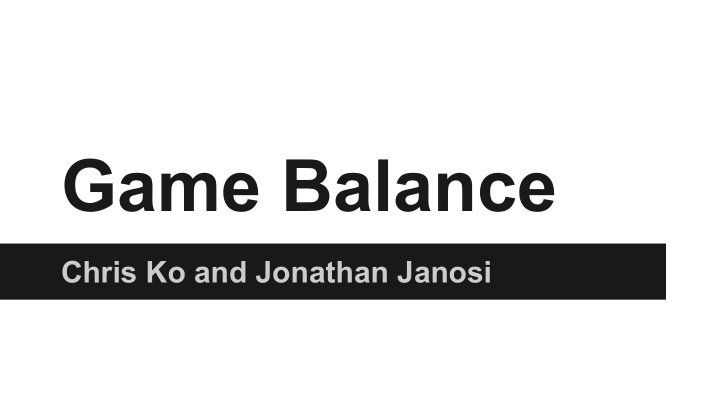



Game Balance Chris Ko and Jonathan Janosi
“A good game is a series of interesting choices.” - Sid Meier
Balancing Games 2 Major issues ● Fairness (PvE) ● Difficulty (PvP) What is a balanced game?
Characteristics of a Balanced Game ● Provides meaningful choices ● Role of Chance << Role of Skill ● The game seems fair (PvP) ● Any player gets a reasonable opportunity to catch up when falling behind (PvP) ● The game seldom or never results in a stalemate (PvP) ● The game seems fair (PvE) ● The difficulty must stay consistent (PvE)
Dominant Strategies A strategy that produces the best results NO MATTER what the other player does. *Includes strategies that can prevent a team from losing.* What is an example of a dominant strategy?
Dominant Strategy example Akuma (Super Street Fighter II)
Avoiding Dominant Strategies Transitive Relationships ● On a scale ● Make it interesting! ○ Direct costs ○ Indirect costs (Shadow Cost)
Shadow Cost Example Weapon choices in Bastion
Avoiding Dominant Strategies Intransitive Relationship ● RPS ● A decision can produce a winning outcome or a losing outcome.
Avoiding Dominant Strategies Orthogonal Unit Differentiation ● Each type of unit should be orthogonally different from the rest.
Orthogonal Design Example
Chance in games ● Chance in games can leads to some negative consequences ● While chance is not intrinsically bad, using it wrong can cause a game to seem unfair ● Chance should be used sparingly. The majority of players actions should be based on skill.
Chance in Games ● Use chance is actions with that happens frequently with small risks and rewards ○ having an attack do 10-20 damage twice a second is fine, as the action happens frequently enough the chance will quickly reach and average ● Tell the player the odds, and let them choose which actions they believe are beneficial
Chance example Diablo II Sorceress Tree
Balance through symmetry ● In PvP games, you can choose to balance the game symmetrically ● It is usually easier to create a balanced symmetric game than an asymmetric one ○ This tends, however, to be considered a less interesting way to do things
Asymmetric Balance ● Asymmetrically balanced games tend to be more prone to dominant strategies ○ Requires more testing to ensure balance ● You not only have to worry about the odds being fair but that players percieve the game as fair
Making PvE games fair ● Avoid sudden difficulty spikes. Try to keep the game at a consistent level of difficulty. ● Avoid “learn-by-dying” sections. A player should feel adequately warned about danger. Super Meat Boy Gameplay
Making PvE games fair ● Give players the information they need to succeed. ● All knowledge required to complete the game should be contained in the world itself. ● The game should not contain challenges outside of it’s genre. If it is a hybrid genre, this should be clear from the start.
Difficulty ● With PvE games, difficulty needs to be balanced so that it is not too easy (boring) or too hard (stressful) - in the ‘flow’ ○ This can be a hard process, as players both bring varying amount of skill alongside varying expectations of difficulty Dark Souls Gameplay
Absolute vs. Perceived ● Absolute difficulty measures the amount of skill required to beat the challenge. ● Perceived difficulty is what players care about. It is the absolute difficulty of the game relative to how much skill and experience they have. Abs Diff = (ISR + Stress - Power provided - Prev exp) Per Diff = (ISR + Stress)
Absolute vs Perceived
Difficulty vs. Power ● Often, games will have the player either “level up” or get more powerful equipment ● The relative difficulty is the measure of the challenge of the game with the power provided. Perceived Difficulty=Absolute Difficulty - (Power Provided + Game Experience)
Difficulty Progression ● Perceived difficulty should stay consistent if not slightly increasing ● Saw-tooth difficulty
Difficulty vs Time
Difficulty vs time
Saw-Tooth Difficulty
Balancing PvP Games 2 Types of PvP games ● Symmetric ● Asymmetric
Balancing PvP Games Asymmetric Games ● Player effectively play by different rules ● Testing balancing is very hard ● Playing w AI can be an asymmetric game
Asymmetric Game
Balancing PvP Games Balancing through ‘Point Assignment System’ ● each attributes should be orthogonal ● each point should provide the same amount of ‘power’ ● Can be static or dynamic.
Point Assignment System
Balancing PvP Games Balancing in Persistent Worlds ● ALWAYS IMBALANCED (low lvl - high lvl) ● Resources must flow in ● Balance ‘on the fly’ ○ trolls & cry babies ● Market Force ○ set audiences
Persistent World
Difficulty Modes ● Increases audience range ● Accounts for Abs Difficulty ● Dynamic Difficulty Adjustments
DDA
Positive Feedback
Positive Feedback Game design principles to positive feedback ● Don’t provide too much power ● Introduce negative feedback ● Raise ABS difficulty ● Allow collision against the leader ● Define victory in terms unrelated to the feedback loop ● Use chance to reduce rewards.
Avoiding Stagnation ● Stagnation is where a player feels stuck where there are not ● Caused by not making sure the player is given enough information to know how to proceed
Avoiding Stagnation Often solved by giving the players clues or hints when they seem stuck
Avoid trivialities ● Don’t bog the players down with boring, obvious choices ● Avoid giving the player decision which ultimately don’t affect gameplay
General Balancing Tips ● Change one thing at a time ● Make big changes, not small ones ● Keep records ● Use pseudo-random numbers (for testing, not necessarily in the game itself)
Recommend
More recommend